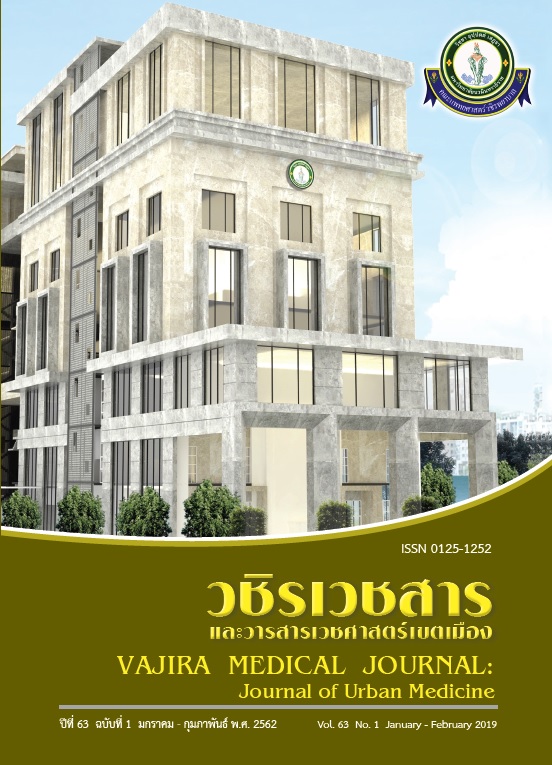Calibration of an instrumented couch with a motioncapture system in measuring force applied and distance during manual therapy
Main Article Content
Abstract
Objective: This study aimed to (i) describe an instrumented couch which would be able to synchronize with the motion-capture system in details; (ii) calibrate this device in measuring applied forces on its surface and distance.
Study design: The criterion-related validity and test-retest reliability.
Methods: The criterion-related validity and reliability of the couch were investigated in two
conditions: empty couch and a couch with dead weight of known mass 70 kg., in three directions (vertical, medial-lateral and caudad-cephalad directions). The motion-capture system was also investigated by using the grid paper size 40×40 cm2. Pearson’s correlation and the intraclass correlation coefficient (2, 1) were used to analyze the validity and the reliability of the couch in measuring the applied force and motion-capture system in measuring the distance. The percentage error was calculated for both the couch and the motion-capture system.
Results: The Pearson’s correlation of the couch and the motion-capture system in this study was 1.00 (p<0.05). The intraclass correlation coefficient (2, 1) of the couch was 1.00 (p<0.05). The average percentage error of the couch in measuring the applied force and the motioncapture system in measuring the distance ranged from 0.41-1.12% and 0%, respectively.
Conclusion: The instrumented couch and the motion-capture system are appropriate to investigate both amount of force applied and displacement during manual therapy.
Downloads
Article Details
References
2. Lee R, Evans J. Load-displacement-time characteristic of the spine under posteroanterior mobilization. Aust J Physiother 1992;38:115-23.
3. Latimer J, Lee M, Goodsell M, Maher C, Wilkinson B, Adams R. Instrumented measurement of spinal stiffness. Man Ther 1996;1:204-9.
4. Edmondston SJ, Allison GT, Gregg CD, Purden SM, Svansson GR, Watson AE. Effect of position on the posteroanterior stiffness of the lumbar spine. Man Ther 1998;3:21-6.
5. Hessell BW, Herzog W, Conway PJ, McEwen MC. Experimental measurement of the force exerted during spinal manipulation using the Thomson technique. J Manipulative Physiol Ther 1990;13:449-53.
6. Matyas TA, Bach TM. The reliability of selected techniques in clinical arthrometrics. Aust J Physiother 1985;31:175-99.
7. Petty NJ, Messenger N. Can the force platform be used to measure the forces applied during a PA mobilisation of the lumbar spine? J Man Manip Ther 1996;4:70-6.
8. Harms MC, Milton AM, Cusick G, Bader DL. Instrumentation of a mobilization couch for dynamic load measurement. J Med Eng Technol 1995;19:119-22.
9. Chiradejnant, A, Maher CG, Latimer J. Development of an instrumented couch to measure forces during manual physiotherapy treatment. Man Ther 2001;6:229-34.
10. Snodgrass SJ, Rivett DA, Robertson VJ. Calibration of an instrumented treatment table for measuring manual therapy forces applied to the cervical spine. Man Ther 2008;13:171–9.
11. McGregor AM, Wragg P, Gedroyc WMW. Can intervention MRI provide an insight into the mechanics of a posterior-anterior mobilization. Clin Biomech 2001;16:926-9.
12. Powers CM, Kulig K, Harrison J, Bergman G. Segmental mobility of the lumbar spine during a posterior to anterior mobilization: assessment using dynamic MRI. Clin Biomech (Bristol, Avon) 2003 (1);18:80-3.
13. McGregor AM, Bull AMJ, Lee R, Wragg P. Dynamic response of the human spine to anteroposterior mobilization manual therapy: an interventional magnetic resonance imaging study. Physiotherapy 2004;90:165-6.
14. Kulig K, Landel R, Powers CM. Assessment of lumbar spine kinematics using dynamic MRI: a proposed mechanism of sagittal plane motion induced by manual posterior to anterior mobilization. J Orthop Sports Phys Ther 2004;34:57-64.
15. Watson MJ, Burnett M, Dickens W. Experiment in recording passive spinal movement. Physiotherapy 1989;75:747-9.
16. Gal J, Herzog W, Kawchuk G, Conway P, Zhang YT. Force and relative vertebral movement during SMT to unembalmed post-rigor human cadavers: peculiarities associated with joint cavitation. J Manipulative Physiol Ther 1995;18:4-9.
17. Gal J, Herzog W, Kawchuk G, Conway P, Zhang YT. Measurements of vertebral translations using bone pins, surface markers and accelerometers. Clin Biomech (Bristol, Avon) 1997;12:337-40.
18. Portney LG, Watkins MP. Foundations of clinical research: applications to practice. The United States of America: Appleton & Lange; 1993.


